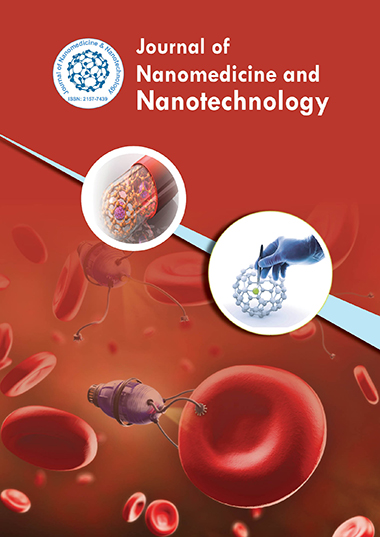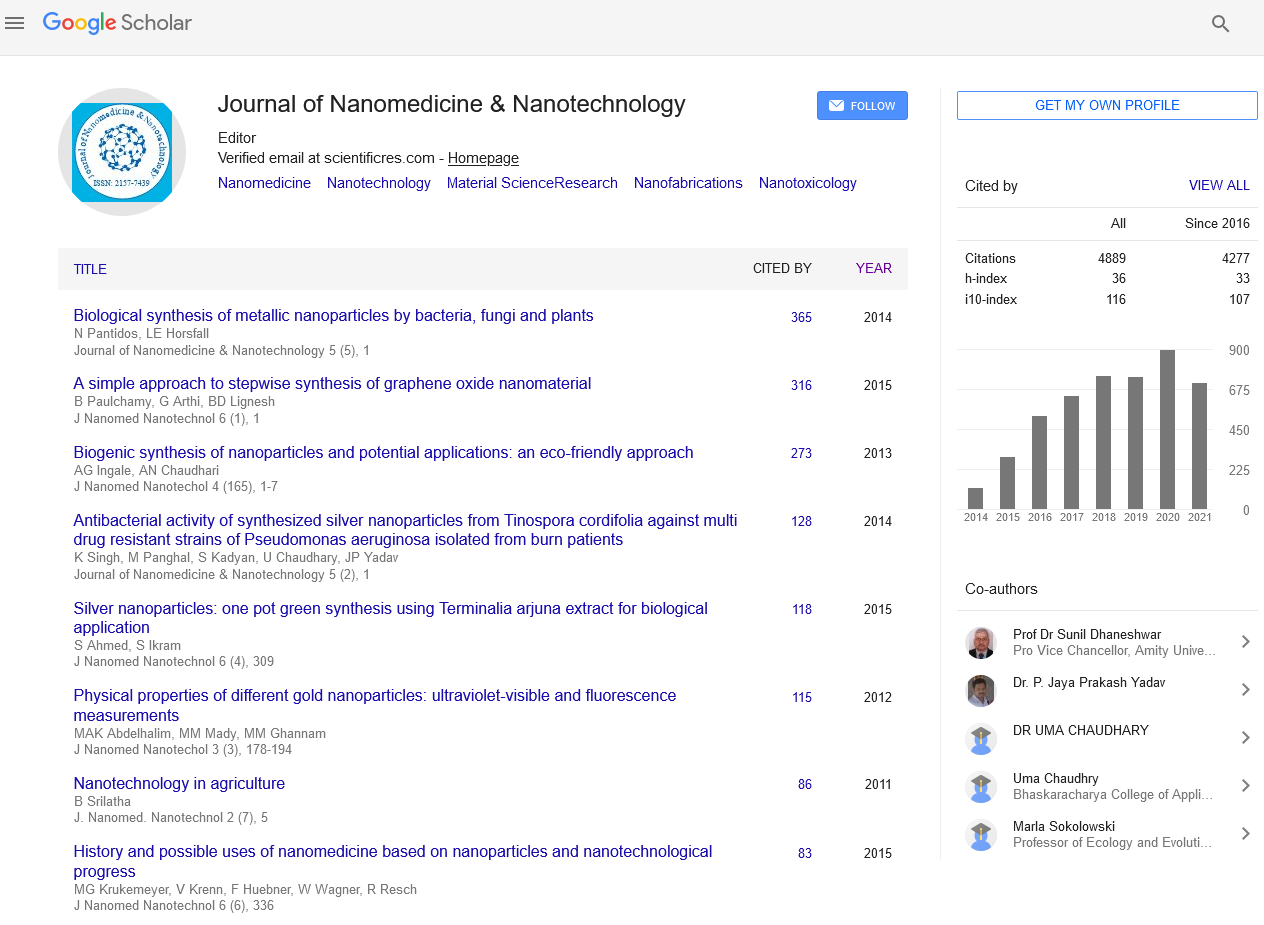Indexed In
- Open J Gate
- Genamics JournalSeek
- Academic Keys
- JournalTOCs
- ResearchBible
- China National Knowledge Infrastructure (CNKI)
- Scimago
- Ulrich's Periodicals Directory
- Electronic Journals Library
- RefSeek
- Hamdard University
- EBSCO A-Z
- OCLC- WorldCat
- SWB online catalog
- Virtual Library of Biology (vifabio)
- Publons
- MIAR
- Scientific Indexing Services (SIS)
- Euro Pub
- Google Scholar
Useful Links
Share This Page
Journal Flyer

Open Access Journals
- Agri and Aquaculture
- Biochemistry
- Bioinformatics & Systems Biology
- Business & Management
- Chemistry
- Clinical Sciences
- Engineering
- Food & Nutrition
- General Science
- Genetics & Molecular Biology
- Immunology & Microbiology
- Medical Sciences
- Neuroscience & Psychology
- Nursing & Health Care
- Pharmaceutical Sciences
Editorial - (2024) Volume 15, Issue 5
Nanosensors for Early Disease Detection Innovations and Applications
Zahara Bloomfield*Received: 03-Sep-2024, Manuscript No. jnmnt-24-27232; Editor assigned: 05-Sep-2024, Pre QC No. jnmnt-24-27232 (PQ); Reviewed: 20-Sep-2024, QC No. jnmnt-24-27232; Revised: 24-Sep-2024, Manuscript No. jnmnt-24-27232 (R); Published: 30-Sep-2024, DOI: 10.35248/2157-7439.24.15.755
Abstract
Nanosensors have emerged as a groundbreaking technology in the field of early disease detection, offering high sensitivity and specificity for a wide range of biomarkers. This article reviews the latest advancements in nanosensor technology, including their design, mechanisms of detection, and applications in diagnosing diseases such as cancer, cardiovascular disorders, and infectious diseases. The potential of nanosensors to transform early diagnosis and personalized medicine is discussed, along with the challenges and future directions in this rapidly evolving field.
Keywords
Nanosensors; Early Disease Detection; Biomarkers; Cancer Diagnostics; Personalized Medicine
INTRODUCTION
Early disease detection is crucial for effective treatment and improved patient outcomes. Traditional diagnostic methods often lack the sensitivity and specificity needed for early-stage disease identification. Nanosensors, with their unique properties and capabilities, have emerged as a promising solution for detecting biomolecules at low concentrations. These devices leverage nanomaterials to enhance detection limits and provide rapid, real-time results, making them ideal for point-of-care diagnostics [1].
TYPES OF NANOSENSORS
Nanosensors can be categorized based on the type of nanomaterials used and the mechanisms of detection employed. The following are some of the most commonly studied types
Metal Nanoparticle-Based Sensors
Metal nanoparticles, such as gold and silver, exhibit unique optical and electronic properties that make them effective for biosensing applications. Surface plasmon resonance (SPR) in these nanoparticles can be utilized to detect specific biomolecules through changes in light absorption or scattering [2].
Carbon Nanotube Sensors
Carbon nanotubes (CNTs) possess exceptional electrical conductivity and large surface area, making them suitable for electrochemical sensing. When functionalized with specific antibodies or aptamers, CNTs can selectively bind target biomarkers, leading to measurable electrical signals.
Quantum Dot Sensors
Quantum dots (QDs) are semiconductor nanoparticles that emit fluorescence upon excitation. Their size-dependent optical properties can be harnessed for sensitive detection of biomolecules. QDs can be conjugated with antibodies or peptides to enhance specificity in detecting target analytes.
Graphene-Based Sensors
Graphene, known for its excellent electrical and mechanical properties, is an emerging material in nanosensor technology [3]. Graphene-based sensors can detect changes in conductivity or capacitance when target biomolecules are adsorbed onto their surface, providing a sensitive detection mechanism.
MECHANISMS OF DETECTION
Nanosensors employ various mechanisms for detecting biomolecules, each with distinct advantages:
Optical Detection
Optical detection methods, such as SPR and fluorescence, leverage changes in light properties to identify biomolecules. For example, gold nanoparticles can exhibit a color change in the presence of specific analytes, allowing for visual detection.
Electrochemical Detection
Electrochemical sensors measure changes in current or voltage in response to biomolecule binding. This method offers high sensitivity and is suitable for portable applications [4]. The use of CNTs or graphene enhances the conductivity and responsiveness of these sensors.
Mass-Based Detection
Mass-based detection methods, such as surface acoustic wave (SAW) sensors, utilize changes in mass or frequency when biomolecules bind to the sensor surface. This approach can detect low concentrations of analytes with high specificity.
APPLICATIONS IN DISEASE DETECTION
Cancer Diagnostics
Nanosensors have shown significant potential in cancer diagnostics through the detection of tumor markers and circulating tumor cells (CTCs). For instance, gold nanoparticle-based sensors can detect prostate-specific antigen (PSA) at low concentrations, enabling early prostate cancer detection [5]. Similarly, CNT-based sensors can identify specific RNA biomarkers associated with breast cancer.
Cardiovascular Disease Detection
Cardiovascular diseases often go undiagnosed until advanced stages, emphasizing the need for early detection methods. Nanosensors can detect biomarkers such as troponin and B-type natriuretic peptide (BNP), which are indicative of heart failure and myocardial infarction. Graphene-based sensors have shown promise in detecting these biomarkers with high sensitivity.
Infectious Disease Diagnosis
Rapid and accurate diagnosis of infectious diseases is critical for controlling outbreaks. Nanosensors can detect viral and bacterial pathogens through the identification of specific nucleic acids or proteins [6]. For example, QD-based sensors can rapidly identify viral RNA, facilitating early diagnosis of diseases like COVID-19 and influenza.
ADVANTAGES OF NANOSENSORS
High Sensitivity and Specificity: Nanosensors can detect biomolecules at extremely low concentrations, significantly improving early detection capabilities.
Rapid Results: Many nanosensor technologies provide real-time results, enabling timely clinical decisions and interventions.
Portability and Miniaturization: The small size of nanosensors allows for the development of portable diagnostic devices, suitable for point-of-care testing in various settings.
Multiplexing Capability: Nanosensors can be designed to detect multiple biomarkers simultaneously, enhancing diagnostic accuracy and providing comprehensive disease profiles [7].
CHALLENGES AND LIMITATIONS
Despite their potential, nanosensors face several challenges:
Biocompatibility: Ensuring that nanosensors do not elicit adverse biological responses is critical for safe use in clinical settings. The toxicity of certain nanomaterials must be carefully evaluated.
Stability and Shelf Life: Maintaining the stability of nanosensors during storage and use is essential for reliable performance. Degradation over time can impact their effectiveness.
Regulatory Approval: The pathway for regulatory approval of nanosensor technologies can be complex, requiring extensive validation studies to demonstrate safety and efficacy [8].
Integration with Existing Systems: Incorporating nanosensors into existing healthcare infrastructures presents challenges, including the need for compatible data management systems and training for healthcare professionals.
FUTURE PERSPECTIVES
The future of nanosensors for early disease detection is promising, with ongoing research focusing on improving sensitivity, specificity, and user-friendliness. Innovations such as smart biosensors that integrate with mobile devices for data analysis and transmission are being developed [9]. Furthermore, advancements in nanomaterials and nanofabrication techniques are expected to enhance the functionality and versatility of nanosensors [10].
CONCLUSIONS
Nanosensors represent a transformative technology in the field of early disease detection, offering unprecedented sensitivity and specificity for a wide range of biomarkers. Their potential applications in cancer, cardiovascular, and infectious disease diagnostics highlight their importance in improving patient outcomes through timely interventions. Addressing the challenges related to biocompatibility, stability, and regulatory approval will be crucial for the successful integration of nanosensors into clinical practice. As research and development in this field continue to advance, nanosensors are poised to play a vital role in the future of personalized medicine.
REFERENCES
- Bai Y, Li Y, Zhang G, Hou X. Understanding the mechanisms of graphene-based nanomaterials as drug carriers: a theoretical perspective. Phys Chem Chem Phys. 2020; 22(29): 16544-16556.
- Garg S, Liao W, El-Kadi AO. Understanding the interaction of dietary polyphenols with mammalian drug metabolizing enzymes. Curr Drug Metab. 2020; 21(6): 416-429.
- Zhang Y, Zhang R, Su H. Interaction of ligand-bound nanoparticles with cell membranes: from specific binding to nonspecific penetration. Langmuir. 2019; 35(3): 677-688.
- Li C, Li Q, Zeng Z, Zhou X. Dispersions of hydrophobic magnetite nanoparticles in nonpolar solvents with different surfactants: the effect of surfactant chain length and surfactant concentration. J Colloid Interface Sci. 2019;539: 567-577.
- Zhang S, Bellinger A, Genshaft A. A blood–brain barrier–penetrating gut-microbe-derived molecule that enhances amyloid beta deposition and cognitive impairment in a mouse model. Science Advances. 2021; 7(23): eabf1773.
- Tong R, Chiang HH, Kohane DS. Photoswitchable nanoparticles for in vivo cancer chemotherapy. Proc Natl Acad Sci. 2020; 110(46): 19048-19053.
- Sarvi F, Mahmoodzadeh A, Kiani M. A novel mathematical model for the effective drug administration and the drug concentration in brain tumor. J Drug Deliv Sci Technol. 2021; 61:102275.
- Ranade A R, Zhang H, Drueckhammer D G. 3D-QSAR Models for Arylcarboxamides as Potent and Selective Human Beta 3 Adrenergic Receptor Agonists. J Chem Inf Model. 2018; 58(7): 1476-1487.
- Shi Y, Zhao R, Zhang Q, Wei Y, Zhao Y. Molecular Dynamics Simulation-Guided Rational Design of Polymer Nanocarriers for Drug Delivery. Nanoscale Res Lett. 2019; 14(1): 372.
- Jiang H, Du L, Li L. Multiscale modeling and experimental study on the self-assembly of telo-dendrimers. J Mol Model. 2021; 27(1): 1-13.
Indexed at, Google Scholar, Crossref
Indexed at, Google Scholar, Crossref
Indexed at, Google Scholar, Crossref
Citation: Zahara B (2024) Nanosensors for Early Disease Detection Innovations and Applications. J Nanomed Nanotech. 15: 755.
Copyright: ©2024 Zahara B. This is an open-access article distributed under the terms of the Creative Commons Attribution License, which permits unrestricted use, distribution, and reproduction in any medium, provided the original author and source are credited.
Competing interests: The authors have declared that no competing interests exist.


